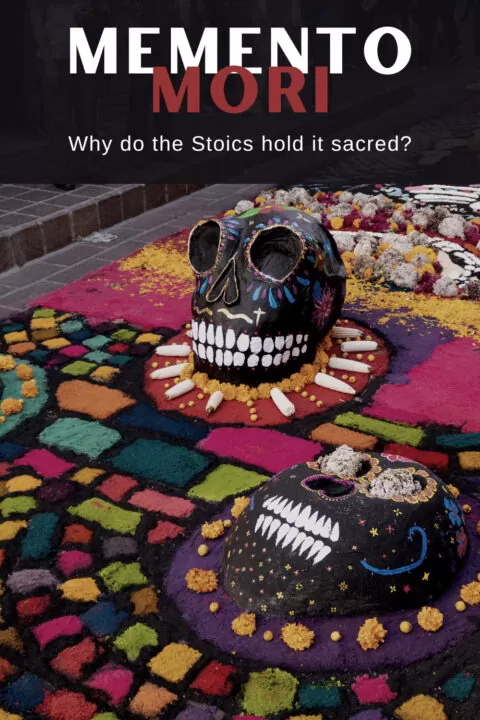Reading time: 10 minutes
Often, Stoicism gets defined as a state of calmness and tranquility regardless of pain, pleasure, grief, or joy. However, in truth, it encompasses much more than that simple perception.The Stoics can be happy just like anyone else, in case you doubt.
Stoicism is a philosophical school started by Zeno of Citium, that flourished in the 3rd century BCE. One of the newer schools of Hellenistic philosophy, it is still in existence in the modern world. It has recently started to become prominent again with the rapid spread of the internet in a tumultuous world.
Stoicism teaches us to live in accord with nature and holds that a good life is one that is lived with virtue.
Practicing Stoicism can help us focus on what is important in life without getting distracted by the things that waste our time and tranquility.

Stoicism For Inner Peace
Since Stoicism involves understanding our turbulent emotions and knowing how they can affect our lives, as well as finding ways to control them, it can help us develop inner peace.
There are many ways to practice Stoicism that will help you achieve inner peace. The best way is to practice it in your own life by living in the moment, practicing virtue, and not worrying about what the future may bring.
Here are a few effective ways that Stoics used to keep their mental peace:
1. Meditating, The Stoic Way.
The Stoics practiced meditation by focusing their attention on their thoughts and sensations. This acted as an effective strategy to accept and release their negative thoughts and emotions.
This was more akin to our modern concept of mindfulness, which is a moment-to-moment awareness of what is happening around and inside us.
To the Stoic, there is no greater place than here, no better time than now.
The Stoic way of meditation involved thinking in solitude, withdrawn from the world around them. It helped them clear their thoughts, understand their desires, and control their actions.
A mindful Stoic paid unwavering attention to the present moment and its realities, almost like a meditative monk, until it cleared his future decisions.
Aurelius says:
“You can get away from it anytime you like. By going within. Nowhere you can go is more peaceful… than your own soul.” (Meditations)
2. Calmly Accepting What Is.
A Stoic accepts the cards life deals them with, without complaint, because they believe such a sequence of events is the perfect expression of cosmic purpose.
The Stoic king Marcus Aurelius reminded himself,
“There are brambles in the path? Then go around them. Don’t demand to know ‘why do such things exist?’” (Meditations).
Marcus meant when we question the existence of something that defies our expectations, our mind fights against it, often jumping to biased conclusions, and loses its peace.
Of course, we can’t have our lives without stressful situations and unexpected happenings. The Stoic way of handling them is to accept them as they are, instead of reacting to them.
Because what actually disturbs our peace is not the events, but our judgments of those events.
“If you are pained by external things, it is not that they pain you, but your own judgment of them; and it is in your power to wipe out that judgment now.” (Meditations)
And Voltaire, one of the greatest French writers who spoke against the religious and political establishments as early as the 18th century, said:
“Each player must accept the cards life deals him or her: but once they are in hand, he or she alone must decide how to play the cards in order to win the game.”
However, the Stoic acceptance is not passivity, but rather a thing framed by the proposed activity, as we’ll explore next.
That is the idea of Amor Fati (know more about this fascinating Stoic concept).
3. Letting Go of Failures, And Reworking.
When everything seems to be going right, something goes wrong for no obvious reason. Our perfect plans frequently get derailed without warning. This inevitability is what holds human life together, for we wouldn’t like it if our lives always flowed smoothly.
Now, when things go wrong, the Stoic approach to maintaining mental peace is to let it go. But this letting go is different. Epictetus called it The Art of Acquiescence.
Though the dictionary defines acquiescence as submission, compliance, or yielding, its Stoic sense is more truly an acknowledgment. It is the power to acknowledge we have a lot of work ahead of us, for which we must rethink and rework our strategies.
We must undergo a hard winter training, and not rush into things, for which we haven’t prepared. — Epictetus
Acquiescence is not passively resigning to one’s fate, but accepting that the cosmos has a larger plan laid out for us. It is optimism steeped in courage, and hope reinforced by determination. It is the future vision that enables us to see the big picture.
If we do not accept what comes our way, we will keep fighting it and risk losing our agency. In that state of powerlessness, we succumb to whining and carping.
The Fates guide the person who accepts them and hinder the person who resists them. — Cleanthes
4. Remembering Your Mortality: Memento Mori.
Memento mori is the belief that contemplating one’s own death helps to put life’s events into perspective and shows what is truly essential to oneself.
It’s actually remembering that death is inevitable and unpredictable. Death will visit us for certain, but we don’t know when.
Keeping this in mind, we must feel the urgency to do the good things we are capable of and avoid the things that are not virtuous.
Steve Jobs told the graduating class of 2005:
“Every morning I looked in the mirror and asked myself: If today were the last day of my life, would I want to do what I do today?”
Marcus Aurelius famously referred to memento mori in his book:
“You could leave life right now. Let that determine what you do and say and think.” (Meditations)
5. Learning To Deal With Criticism.
People judge us constantly, and often they are not too flattering about us. They don’t stop, no matter how much we will against it.
We also judge people harshly. But we can stop that, the Stoics assure.
Stoicism teaches we cannot always control outside events, but we can always control our internal processes. Like, what thoughts we think about people’s unkind judgments of us.
For example, when we hear or see things that malign us, we must be careful to not attach our value judgments to them. Instead, we should take them at face value.
Remember, their words are only their opinions. Why upset yourself about how someone holds you to an opinion?
When someone provokes you, if you respond with anger or some other negative emotion, your mind is tricked into believing you are being harmed. So it is essential not to respond to impressions impulsively. Take some time before reacting. You will see you are in better control. — Epictetus, Enchiridion
So, the types of thoughts you attach to their actions decide whether you will remain calm or become agitated.
The Stoic philosopher Seneca teaches us how to find inner peace through developing self-control and self-discipline.
You should listen to the insults of the ignorant with equanimity. — Seneca
And Marcus said,
Does someone despise me?
That’s their problem. Mine is to ensure that what I do or say does not deserve sneer.
Does someone hate me?
Again, it is their problem. My job is to be friendly and charitable to everyone including those who hate me and show them their mistake. (Meditations)
7. Understanding Fear And Desire.
Stoicism teaches that there are really only two emotions that dominate our inner and outer world: fear and desire — one creative, the other destructive.
Both of these emotions are powerful yet opposing forces, as they originate from the same place. So, it means that either one can be used to subdue the other if necessary.
Our minds are subject to these two forces, with the creative side usually winning. This leads us to believe we are seeing things clearly, when we might be actually riddled with biases and prejudices.
As a Stoic, one does not readily yield to their desires, does not run away from unpleasant things, enjoys their pleasures calmly, and endures pain with patience.
Simply put, the Stoic way to foster long-term peace is through facing your fears and not giving in to your every desire.
8. Living Strictly By Virtue.
A clear conscience at all times allows for mental peace. To maintain a clear conscience, the Stoics ensure that they do not act in ways that violate their moral code of virtue.
For the Stoics, living in virtue is the only thing that humans must do. Everything else is meaningless unless you follow virtue in your thoughts and actions.
The Stoics laid down their cardinal virtues to help themselves deal with the external issues of human life and still maintain an inner balance.
The four cardinal Stoic virtues are Justice, Moderation, Courage, and Wisdom.
Cultivating the four virtues helped them harmonize with Nature. They believed that humans achieve eudaimonia (a personal state of thriving and fulfillment) only by synchronizing their individual nature with the cosmic Nature.
They prized logic or wisdom above all other virtues because it can be used to identify what is good or bad in any situation. Next came courage, as, without it, no one can take the bold step of following through with their virtuous judgments and righteous decisions.
Read more about it in this authoritative article: Four Stoic Virtues: Greatest Hacks To A Good Life.
9. Weeding Out The Bad Choices.
Everything has more to it than just being good or evil.
We don’t always know how our choices will affect our future. It’s becoming increasingly difficult to tell whether something is clearly good to us or definitely destructive to our future selves.
Ambiguous situations and gray areas leave us at indecision. And a state of indecision causes us mental pain. However, knowing how to weed out the potentially damaging choices bodes well for our serenity.
This is an art that the Stoics have mastered: reaching the right decisions fast.
A Stoic knows how to always make a clear distinction between what they can change, such as their own beliefs and behavior, and what they cannot change, such as what others think and say about them.
Once this becomes clear, the way to inner peace becomes easy to find and tread on.
Final Words
Don’t expect your peace to come from your expectation of immutability. The ultimate nature of the universe is Change.
Stoic philosophy has withstood the test of time and continues to be a practical, personal philosophy that many people use to cultivate peace of mind.
A Stoic does not expect things to stay the same for them to be at peace. They understand that change is the nature of the cosmos. If we don’t flow with it, we will suffer the consequences of clinging to the past.
As Marcus Aurelius said,
“And if all men refuse to believe that he lives a simple, modest, and contented life, he is neither angry with any of them, nor does he deviate from the way which leads to the end of life, to which a man ought to come pure, tranquil, ready to depart, and without any compulsion perfectly reconciled to his lot.” (Meditations)
• • •
• • •
Author Bio: Written and reviewed by Sandip Roy—a medical doctor, psychology writer, and happiness researcher. Founder and Chief Editor of The Happiness Blog. Writes popular science articles on happiness, positive psychology, and related topics.
• Our story: Happiness Project
√ If you enjoyed this, please share it on Facebook or Twitter or LinkedIn.
